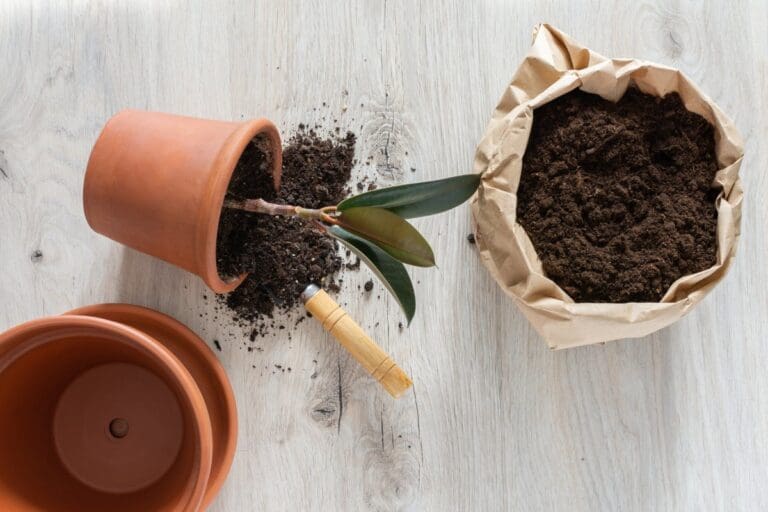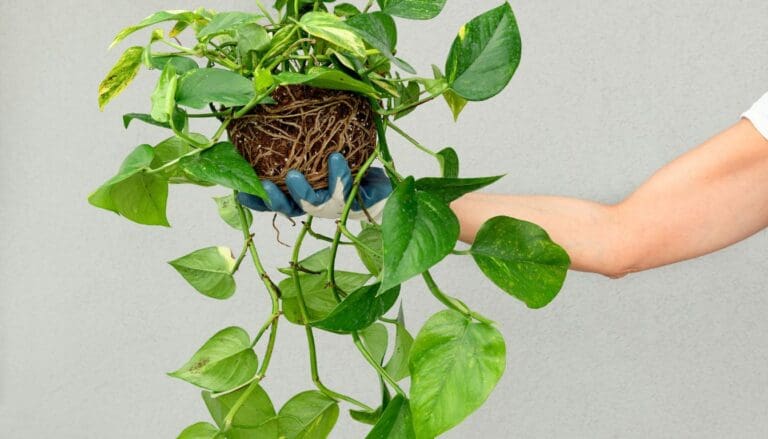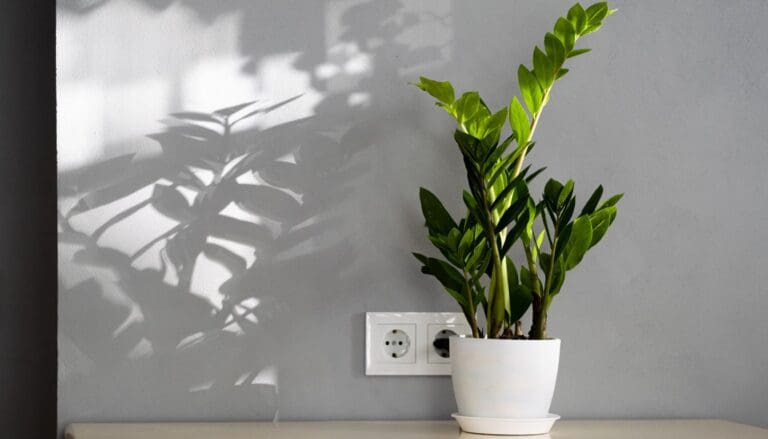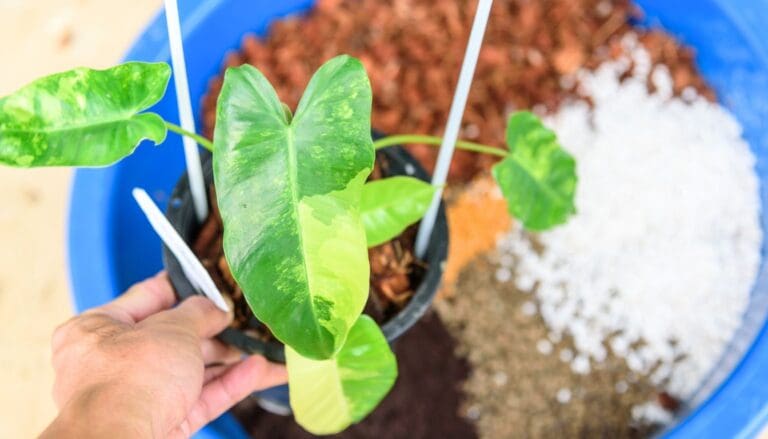How Fast Do Crotons Grow? (Croton Growth Rate)
Crotons are tropical houseplants with dense, colorful leaves that grow best in a warm climate. If you are thinking of growing Crotons, you might be wondering how fast do Crotons grow. That is what I will answer today.
In general, crotons are a slow-growing plant that grows anywhere between 8-12 inches every year. Outdoors crotons can grow up to 10 feet in height within a few years, but indoors it grows to about 3 feet in a couple of years. The growth rate depends on the species of croton you bought.
Season, light, watering, and humidity affect Croton’s growth rate. Adequate watering, monthly fertilization, and proper lighting can encourage faster growth by providing ideal warm temperatures and bright indirect light.
This article will dive into how fast your crotons grow, discuss all the factors that will affect your crotons’ growth, and suggest ways to encourage faster growth in Crotons.

Please note: Simplify Plants is reader-supported. Some links in the post are affiliate links and I get a commission from purchases made through links in the post.
Do crotons grow slowly?
Yes, Croton is considered a slow to moderate growing houseplant. A Croton plant may take 2-3 years to reach maturity. Every year they increase their height by 12 inches during the growing season.
Crotons grow new leaves every 3-4 weeks in the months of spring and summer. They don’t show any growth during winter, but they still absorb nutrients.
Crotons in the wild can grow up to 10-12 feet tall, with a growth rate of 24 inches per year. But when grown as indoor plants, if they receive all ideal conditions, they can grow 6 feet wide and 8 feet tall.
Also, different varieties of Crotons have different growth rates. But on average, they don’t grow more than 3 feet tall if grown as houseplants.
The leaves of crotons are 2-12 inches long and are quite variable. They have large leaves cluster that makes them look dense and elegant. They are easy-care, slow-growing houseplants that make them preferable for many growers.
Factors affecting the growth of crotons
If you provide your Crotons with all ideal conditions, they will grow well at a moderate speed. But you need to take care of all the factors affecting your plant’s growth.
Do not neglect their basic requirements and provide everything in moderation. Take care of their watering, feeding, and environmental factors so that your Crotons can grow faster.
The factors affecting the growth of a Croton plant are:
Let us now understand all these points in detail.
Season
The first factor that determines your plant growth is the season. Like any other plant, Crotons also experience two types of seasons: growing season and dormant season.
The growing season is the ideal time for your crotons to grow. It starts from spring to summer. During this period, your Crotons will grow new sets of colorful leaves. They will show 10-12 inches of growth during this season.
It is that period when your Crotons are the happiest as they receive all the ideal growing requirements such as enough sunlight, temperature, humidity, etc.
The dormant season for crotons is when winter arrives. Crotons do not hibernate during winters, but they rest and don’t grow. Crotons can’t tolerate low temperatures or cold drafts and sometimes start dropping their leaves out of protest.
In winters, you need to give the plant proper care, such as providing them with bright indirect light, maintaining enough humidity and temperature.
Also read: What Temperature Can Croton Tolerate? (+Ideal Temperature Range)
Lighting

Light is the most crucial factor determining any plant’s growth. The plant needs light for performing photosynthesis, which converts light, water, and nutrients into the food.
If Crotons photosynthesize better, they will grow faster. But if they fail to perform photosynthesis due to poor light, the plant will slow down its growth and struggle to survive.
Too much or too little sunlight can result in faded leaves and slow growth. To ensure good growth, provide plenty of sunlight. Provide at least 6-8 hours of full sunlight daily to your Crotons.
Keep your Crotons in a south or west-facing window as this location will give them the ideal light. Keep them one foot away from the window if the sunlight gets too intense.
Also read: What Kind Of Light Does A Croton Need? (Croton Light Requirements)
Watering
A proper understanding of your plant’s watering needs is crucial if you want to see them growing fast. Crotons prefer moist soil but never soggy soil.
Crotons love plenty of water, but too much dampness can cause root rot problems.
They will require an inch of water per week during the growing season. Signs such as wilting during the summer months indicate that they are thirsty and need watering.
During winter, water them every two weeks. Also, mist your crotons every 3 to 4 times during the growing season.
Always test the soil for moistness before watering. If the top layer is dry, water immediately. But if you find that the topsoil is still damp, avoid watering.
Crotons suffer a lot if they sit in waterlogged soil, so always let the soil dry in between watering.
Also read: How Often To Water Croton Plant? (Watering Schedule+Watering Problems)
Nutrients

Croton needs additional nutrients as fertilizers because the soil may not provide all the essential nutrients necessary for optimum growth.
These plants need fertilizers every 2 to 3 weeks in the months of spring and summer when they are actively growing.
Fertilizing once a month is adequate during the dormant season as it is their resting period, and they do not focus on growth. You can even skip fertilizing during this time.
Apply well-balanced slow-release granular fertilizer with NPK ratio 3-1-2 to your crotons. The fertilizers must include all essential nutrients such as nitrogen, potassium, and phosphorous.
You need to sprinkle the granules at the base of the plant and mix it with the top layer of soil. After fertilizing, water the plant thoroughly so the fertilizers can properly get absorbed in the soil.
Before fertilizing, read the feeding quantity and instruct properly to avoid overfertilization issues.
Also read: What Fertilizer Is Good For Croton? (Best Fertilizer For Croton Plant)
Soil
Crotons prefer a well-drained, well-aerated moist soil enriched with lots of nutrients. The soil mix should be slightly acidic.
Choose a soil mix that should hold enough moisture for the roots and drain the excess water. Also, make sure the soil’s pH level remains between 4.5 and 6.5 on the pH scale.
The best potting mix for crotons would be:
- 30% of potting soil
- 20% of perlite
- 25% of peat moss
- 25% of compost
Adding ingredients like potting soil, perlite, and peat moss will provide a bit of everything, such as drainage, retention, and aeration, and ingredient like vermicompost will make the soil more nutritious.
Also read: What Kind Of Soil Does A Croton Need? (+Ideal Soil Mix & Requirements)
Pot

The pot’s size and drainage level both determine plants growth. The pot for crotons should be 1/3 larger than its root ball. While repotting, choose a pot 1 to 2 inches larger than the current container.
Crotons grow upright, which causes the top side to become heavy, so the same sized pot won’t be suitable as it will not hold the plant’s weight properly.
Never choose a small-sized pot as the plant can get root bound, which will lead to slow growth. Also, choosing a large pot will create overwatering situations, so always buy the correct pot size for your plant.
Ensure the pot has a good number of drainage holes. If the pots lack drainage, it might create a waterlogging situation that will hamper your plant’s growth.
Also read: What Kind Of Pot For Croton? (Pot Size, Material & More)
Temperature
Crotons are native to tropical regions with a warm climate and high temperatures between 60-85°F. They will also grow well at room temperatures if they get enough indirect light as a houseplant.
To ensure consistent growth, try to maintain room temperature above 60°F. If the temperature level falls below 55°F, they may be in shock and cause leaf drop. Leaf drop indicates that cold drafts are affecting your plant.
During winters, the plant will naturally slow down its growth as it is not ideal for them to grow, so it’s not a cause of worry.
When temperatures drop during winters, move them to warm, sheltered sunnier locations. However, keep your crotons away from frosts, cold drafts, air conditioners, as all this can chill your plants.
Also, never keep your plants close to any air ducts as the hot air from it can harm your crotons.
Humidity

Crotons are tropical plants coming from regions with humidity levels above 80%. Humidity primarily affects their growth rate, so they will slow down their growth and start dropping their leaves if they do not get enough humidity.
As indoor plants, Crotons will need a minimum of 40% to 60% humidity to grow.
The air inside the home is primarily dry, so it becomes a little tricky to adjust the moisture requirements. There are many ways you can adapt to maintain humidity around your crotons:
- Keep your crotons away from heaters, air conditions, radiators, and cold drafts, as all these will make the surroundings dry, and plants will struggle to survive.
- Mist the Crotons twice a week during the growing season with warm water.
- Get a humidifier to maintain the ideal humidity range around the plant.
- Group your crotons with other plants to create a humid surrounding.
- Clean the leaves of crotons with a damp cloth every week to remove dust and keep them moisturized.
Also read: Do Crotons Need Misting? (+Maintaining Ideal Temperature)
Pests
Crotons as houseplants are prone to certain types of pests. Pests are primarily attracted to their bushy, variegated leaves. The common pests that attack crotons are mealy bugs, plant scales, spider mites, and thrips.
If these pests are not identified and treated on time, they might kill your Crotons. These pests suck out all the sap from the leaves and stems, spread diseases, and weaken their growth.
Overwatering, low light, and excessive humidity make ideal conditions for pests to attack crotons. If the color and texture of the leaf change and the plants look unhealthy, then understand it’s due to pest infestation.
If you have a pest-infested croton plant, then you should take the following steps:
- First of all, isolate your croton plant from all the other houseplants so that the pest will not infest them.
- Check the type of pest that has attacked your plant and prune all the affected foliage.
- Start washing your crotons plant under running water so that the pests start to fall off the plant.
- Prepare a spray by mixing 2 teaspoons of neem oil, 1 teaspoon of dish soap with 1 liter of water. Apply the spray on both sides of the leaves every week to eliminate the bugs. Then take a cotton swab, dip it in rubbing alcohol and clean the leaves of your plant.
- If all these methods don’t work, purchase pesticides and insecticides as per the pest type and read the directions and label appropriately before using them.
Also read: How Do I Get Rid Of Bugs In My Croton Plant? (Common Bugs+Fix)
How do you stimulate the growth of Crotons?

Pruning is essential to maintain and encourage the growth of your houseplants. To make your Crotons grow faster, you should prune the leggy growth and dead leaves.
Pruning makes the foliage bushier. If you want to remove the dead leaves, cut the leaf stem joining the plant. For removing the leggy growth, prune them just above the leaf node.
Never remove 1/3 of the foliage at a time, as this might well put the plant in shock.
To encourage growth, prune the tips of the stems of your Crotons. You can also prune the stems and branches at any spot where you want more growth.
Always wear gloves and use clean sterilized pruners to avoid diseases. Consider pruning your plants during the growing season, as this is when the plants show maximum growth and will recover from stress faster.

Final words
Crotons are slow-growing houseplants and take a few years to reach maturity. They are easy to care for and maintain. All you need to do is take care of their basic requirements.
I have already mentioned all the points that affect the growth of a Croton plant. Ensure that they don’t get stressed, so keep checking your plant needs. If you find any issue, identify the cause and fix it.
Remember, the care routine for crotons will be different in winters as it is their dormant season, and you need to take care of your plant accordingly, but don’t panic if you don’t notice much growth during this time.
Reference: Sciencedirect, Wikipedia, Wikipedia, Britannica, CABI, Academia, University of South Florida, The University of Georgia.
Recommended Garden Supplies
| Product Image | Our Recommended Gardening Supplies | Check Offers! |
|---|---|---|
Top Top
Top
Top
Top
Top
Top
Top
Top | rePotme Houseplant and Tropical Classic Potting Soil Mix | Check Offer On Amazon |
 Top
Top
Top
Top
Top
Top
Top
Top | Espoma Organic Indoor Plant Food | Check Offer On Amazon |
 Top
Top
Top
Top
Top
Top
Top
Top | GooingTop LED Grow Light 6000K Full Spectrum Clip Plant Growing Lamp | Check Offer On Amazon |
 Top
Top
Top
Top
Top
Top
Top
Top | Soil Moisture Meter | Check Offer On Amazon |
 Top
Top
Top
Top
Top
Top
Top
Top | Govee Hygrometer Thermometer, Bluetooth Enabled! | Check Offer On Amazon |
 Top
Top | LEVOIT Humidifiers for Large Room(Best For Plants) | Check Offer On Amazon |
 Top
Top
Top
Top
Top
Top
Top
Top | Upgraded DIY Automatic Drip Irrigation Kit, 15 Potted Houseplants Support | Check Offer On Amazon |
 Top
Top
Top
Top
Top
Top
Top
Top | Stainless Steel Heavy Duty Gardening Tool Set | Check Offer On Amazon |
 Top
Top
Top
Top
Top
Top
Top
Top | Bonide Insecticidal Soap | Check Offer On Amazon |
 Top
Top
Top
Top
Top
Top
Top
Top | Bonide 32 oz Spray Neem Oil for Organic Gardening | Check Offer On Amazon |
 Top
Top
Top
Top
Top
Top
Top
Top | Garden Safe Fungicide | Check Offer On Amazon |






